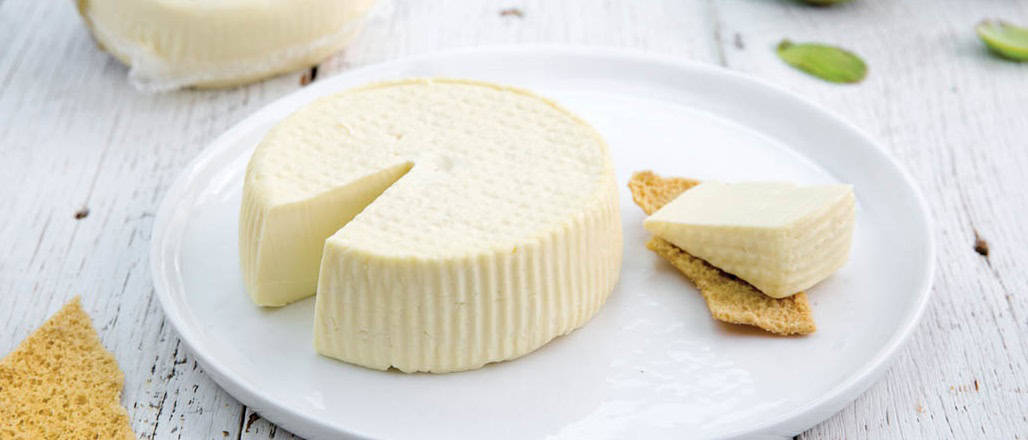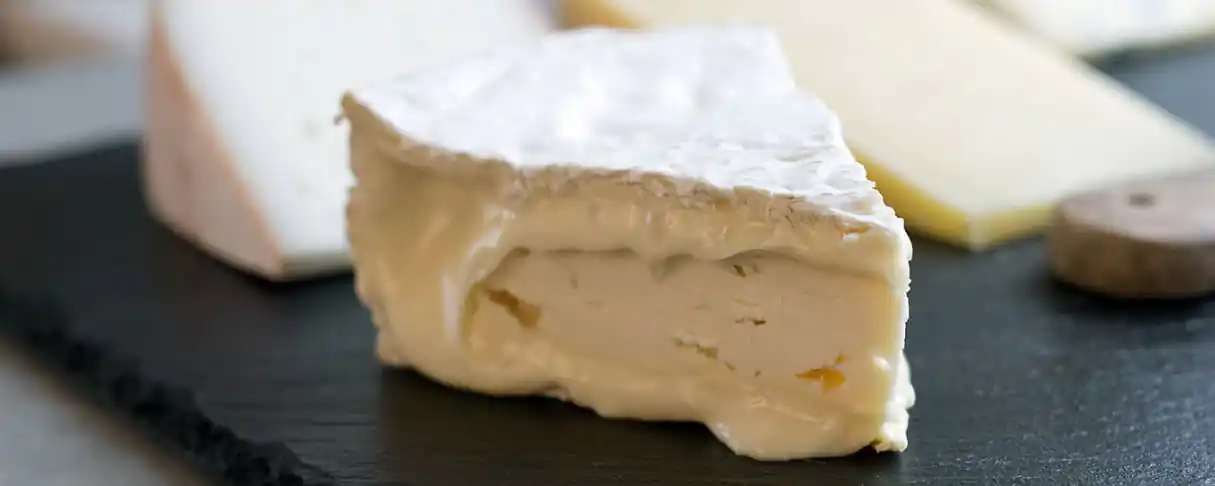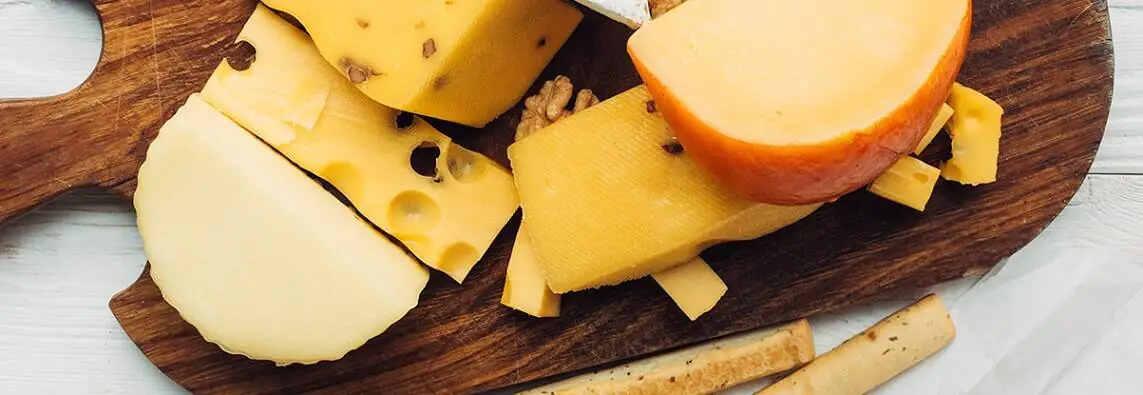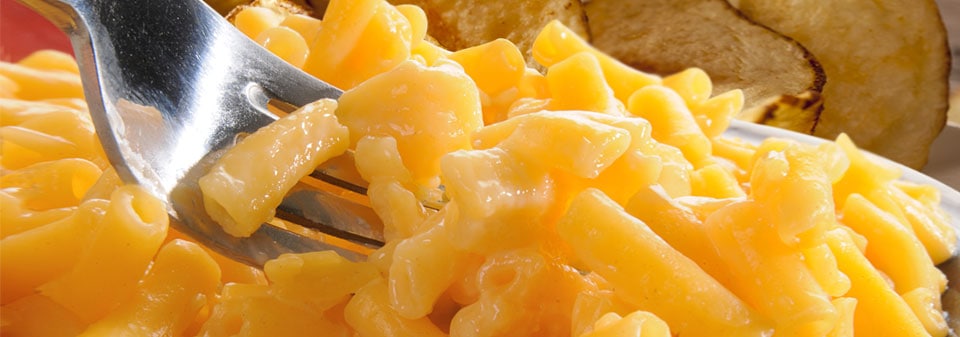American Cheese – The Complete Guide

America’s love for CHEESE is known to the world! Not only as top manufacturers but also as the highest cheese consumers, Americans seem to have aced the taste and mastered the art of all things cheese. The United States offers hundreds of varieties and styles of cheese perfectly crafted to cater to global cuisines and satiate the palates of customers across the globe. Be it a burger, pizza, or pasta, it is incomplete without a great-tasting cheese.
But where did so much love for cheese come from? If history is anything to go by, Americans have inherited their passion for cheese-making and relished it from their ancestors. Nevertheless, over the past decades and centuries, American cheese has undergone an immense transformation. It has changed not only in terms of the manufacturing process but also in terms of variety. From its taste and texture to its packaging and supply, everything has only improved over the years. Let’s find out where it all began. Ready to buy some of your own cheese? Check out our selection!
History of American Cheese
The process of cheese-making dates back to the era when most of the Americans preferred to make it at home, either to consume at home or to sell in the local market. During this time, a variety of European styles persisted in non-commercial cheese-making. However, American industry soon caught up with the manufacturing process and mastered the skill of one type – Cheddar, which went on to become one of America’s most popular cheeses. Cheddar, subsequently, became a common man’s cheese, so much so that Americans simply called it ‘yellow cheese’ or ‘store cheese’.
The United States saw its first cheese revolution in 1851 when Jesse Williams created the first cheese factory in New York. A few decades later, in 1903, James L. Kraft moved to Chicago from Canada and started wholesaling cheese. Slowly came in the concept of processed cheese and cheese singles or slices. Today, considering the amount of cheese that is manufactured in the U.S., it has become the best suited source for the global cheese supply.
Cheddar Cheese

The yellow-orange American cheddar caught the fancy of Americans in the 19th century, which continues today. Cheddar cheese remained the most popular and favourite cheese for the longest time, and currently is the second-favourite after mozzarella with consumption of around 9.6 pounds per capita in 2014, which rose to 11.07 per capita in 2017, as stated by the United States Department of Agriculture.
Although cheddar cheese has a texture similar to its counterparts, what gives it the yellow-orange tinge that differentiates it from the rest? Being milk products, usually, all types of cheese are white or sometimes light yellow, depending upon the milk used. But cheddar is orange. Why? That’s surely not the original colour of the milk it is made from, right? The colour is instead derived from the flavourless Annatto seeds, which are extracted from the tropical Achiote tree. That is what gives Wisconsin cheddar its yellow-golden-orange tinge.
Manufacturing
Interestingly, cheddar cheese gets its name from the process of ‘cheddaring’ during manufacturing. To begin with, the curd and whey are separated using rennet – an enzyme. Then comes cheddaring; an additional step, especially followed to prepare cheddar cheese. Here, after heating, the curd is kneaded with salt, and the whey is drained by cutting it into small pieces, stacked and turned. Vintage cheddar, commonly known as mature or “sharp” cheddar is matured for 15 months or more. The cheese requires special facilities to be kept at a constant temperature. Some cheddar cheese is even matured in the caves.
Cheese : Health Benefits

Contrary to what many people think, cheese is healthy and a great source of calcium, high-quality protein and fat. It contains a good amount of vitamin A and vitamin B12. Additionally, it offers other nutrients like phosphorus, zinc and riboflavin. Cheese, if made of 100% grass-fed animals, is one of the richest sources of various nutrients, which also contains vitamin K2 and omega-3 fatty acids. Fat-soluble vitamins such as vitamin A are retained in the curd at the time of the manufacturing process. This makes cheese a wholesome food.
Cheese is almost essential for good bone health. Calcium helps to maximize peak bone mass and promote rapid skeletal growth to reduce the risk of osteoporosis during late adulthood.
Let’s read about various health benefits cheese has to offer :
This happens to be the primary concern for most of the people who give up cheese – weight gain. However, there is no reason to give up on something that does not necessarily cause weight gain. A wide variety of cheeses of varied calorie and fat content are available in the market. All you need to do is switch to a low-calorie cheese, and you will be fine! Naturally, low-fat cheeses like part-skim mozzarella, cottage cheese or ricotta can be your best bet. Keeping in mind the current trend, US cheese manufacturers have started producing lower-fat cheeses that are low in calories without compromising on the quality, taste, texture and colour.
Moreover, consuming calcium-rich dairy products is consciously becoming a common food habit. Hence, including cheese in your diet may help immensely towards controlling body weight. It can help obese adults to lose bodyweight or body fat when it is eaten as a part of a reduced-calorie diet. According to clinical trials, those who take three to four servings of milk, cheese or yogurt a day while on a low-calorie diet tend to lose more weight and gain more lean muscle mass compared to those who abstain from dairy products.
Cheese reduces the risk of various dental ailments like cavities; it may protect against root cavities, and dental problems commonly found among adults. Additionally, consuming cheese in between meals or snacks may be a good way to ward off tooth decay. Dental cavities are a result of the breakdown of tooth enamel when there are acid-forming dental plaque bacteria that ferment starch and dietary sugar. This process is known as demineralization. Hence, if remineralisation occurs at a faster rate than demineralization, it preserves the quality of teeth for a much longer period. Research has proven that cheese not only prevents acid demineralization of tooth enamel but also supports remineralisation of minor cavities.
Believe it or not, various studies say that cheese has anti-cavity properties. Some varieties of cheese that promote good dental health are Swiss, Blue, Brick, Monterey Jack, Brie, Aged Cheddar, American Processed Cheese, Mozzarella and Gouda.
Moreover, frequent consumption of cheese stimulates the flow of saliva, which has properties to reduce/fight cavities. The protein, calcium and phosphorus present in cheese help neutralize acids and thereby prevent tooth decay. American Dental Association and American Academy of Pediatric Dentistry (AAPD) recommend cheese as a nutritious snack for children and young adults.
According to Dietary Guidelines for Americans, consumption of dairy products is associated with reduced risk of cardiovascular diseases in adults. Although cheese is a source of saturated fat, research findings have doubts about the role of saturated fat in increasing cardiovascular diseases. On the contrary, studies have suggested that dairy products like cheese have a beneficial effect on the heart and its overall health. In comparison to butter, cheese is believed to lower the low-density lipoprotein cholesterol (LDL) and increase high-density lipoprotein cholesterol (HDL). Cheese, when taken in moderation, can help to reduce risk factors for heart diseases like hypertension atherosclerosis (hardening of the arteries), and blood clots. .
Dietary patterns such as DASH – Dietary Approaches to Stop Hypertension can help further. It is a low-fat diet which includes three servings of dairy foods a day, for instance, regular low-fat cheeses, yogurt and low-fat or toned milk. Cheese may also have a beneficial role in reducing metabolic syndrome, which is responsible for cardiovascular diseases and type 2 diabetes.
When it comes to children, cheese can serve as one of the best snacks – healthy, nutritious and filling at the same time. Especially when you are travelling, the various on-the-go varieties of cheese like sticks, slices/singles, cubes and shreds are quite convenient to carry. Cheese consumption in moderation with the meal or as a snack for children is common in the US. It not only provides energy and nutrients required for proper growth and development, but also supports bone health, protects teeth from cavities and lowers body fat.
Gastrointestinal symptoms or problems such as diarrhoea and bloating are usually caused by lactose intolerance. Lactose is one of the principal carbohydrates present in the milk. When the lactose in the milk products is not digested completely, it causes a disturbance in intestine resulting into gastrointestinal symptoms. However, if you think that eating cheese is one of the leading causes for your indigestion, you need a reality check!
Many varieties of cheese – hard as well as natural like cheddar, Colby, Swiss, Monterey jack, etc. contain very little or no lactose at all. Additionally, it has been studied that all those who have been lactose intolerant can consume aged cheeses without any difficulty in digestion. In fact, the American Academy of Paediatrics, the National Medical Association and the 2010 Dietary Guidelines for Americans recommend aged cheeses for all those who suffer from lactose intolerance.
Various Styles of Cheese

- Block
- Barrel
- Loaf
- Daisy
- Wheel
- Moon
- Longhorn
- Cubed & crumbled
- Slices, singles, grated, shredded
- Stringed cheese
Types of Cheese based on Popularity
Here are the popular varieties of cheeses available in the US market and consumed by Americans.
- Cheddar
- Colby
- Cream Cheese
- Monterey Jack
- Mozzarella
- Pasteurised Processed Cheese
- Reduced Fat Cheeses
- Ricotta
- Shredded Cheeses
- Swiss
Types of Cheese based on the Degree of Hardness
The cheeses mentioned above are based on popularity and consumption. Now, let’s see the types of cheese based on the degree of hardness – from soft, creamy cheese to hard, grated cheese and powders. This too is a common way of organising cheese varieties :
Soft-Fresh Cheeses

- Cottage cheese
- Cream cheese – plain & flavoured
- Feta
- Mascarpone
- Neufchâtel – plain & flavoured
- Queso Blanco
- Ricotta – whole milk, low-fat, fat-free
Soft-fresh cheeses are mainly referred to as acid-set or direct-set. Manufacturing these cheeses includes coagulation of milk with lactic acid, lemon juice, vinegar or a similar acid that is directly added to the milk, instead of rennet and enzymes. Later, the whey is drained from soft cheeses using gravity rather than mechanical pressure. This gives the cheese its velvety texture and higher moisture content. Many soft cheeses are packed in tubs, without being cut, pressed into a form or aged. The moisture content in such types of cheeses is the highest, which make them excellent ingredients for fillings and spreads. They are made from top-quality US milk and have a mild, delicate and creamy flavour.
As mentioned above, soft-fresh cheeses make for great cheese spreads, dips and fillings due to their flexible texture. Use to toss in the salad, dip your favourite bites, sprinkle on your salad or use it as pasta/ravioli fillings – soft-fresh cheese never disappoints. The naturally salty feta cheese goes well with the bland vegetables in the salad. Also, these cheeses are excellent binders often used to put together various ingredients. Additionally, the low-fat and no-fat versions are great options to explore for those who are on restricted diets.
Soft Ripened Cheeses

- Brie (single, double and triple cream and flavoured)
- Camembert
Soft ripened cheeses get their identity from the white mould that forms the outer rind. The mould allows the cheese to ripen from the outside as seen when cutting such type of cheeses. The area closer to the rind softens first and becomes semi-liquid while the centre is firmer and creamier, at times. The more ripened the cheese, the softer the texture, with distinct aroma and flavours.
Such types of cheeses are perfect for cheese platters and even cold appetizers. The soft-ripened cheeses in the US are made from pasteurised milk, ensuring high-quality, and are safe for consumption.
Semi-Soft Cheeses

- Brick, dry
- Washed-rind
- Colby jack
- Fontina
- Havarti
- Limburger
- Monterey jack
- Muenster
- Pepper jack
Semi-soft cheeses are always made with whole milk and never with part-skim milk. Some manufacturers prefer to add cream in the process. The entire process, especially the main ingredient – whole milk is responsible for the soft, creamy texture and excellent melting ability. Semi-soft cheese can be further categorized into dry-rind and washed-rind. Washed-rind cheeses are surface-treated with a bacterial smear and then washed with a solution to encourage the smear to grow. Washed-rind cheeses ripen from the outside in. Dry-rind cheeses are cured without a surface treatment. Semi-soft cheeses can be cubed, shredded, sliced and melted. They have some stretch, and they can be broiled and browned.
Semi-soft cheeses have great melting ability, and this makes them suitable for soups, sauces, casseroles and roulades. They easily blend with any other cheese as well as with various ingredients to make a delicious pizza sauce. The sliced forms are ideal for sandwiches and wraps.
Blue-veined Cheese

- Blue cheese
- Gorgonzola, creamy & crumbly style
Various blue moulds are added directly to the milk. Stainless steel needles are used to pierce the body of the cheese to allow oxygen in and carbon dioxide out of the interior, enabling the mould to thrive. If the cheese has been in vacuum packaging for some time, it will appear almost entirely white. The cheese will start turning its colour to blue as soon as the bag is removed.
Crumble into salads, use them in dressing, soups or sauces, the blue cheeses give you a perfect reason to whip up a tasty gourmet. And the credit goes to its soft, creamy texture and unique taste that goes well with most of the American foods.
Gouda & Edam

- Gouda
- Smoked gouda
- Edam
The manufacturers use specific starter cultures and only the highest quality milk to produce these ‘sweet-curd’ cheeses. The primary difference is that gouda is produced with whole milk, while edam is made with part-skim. Various herbs and spices are added to the curd to get flavoured gouda cheese.
Prepare sauce, soups, dips from them or use them as slices. Gouda is available in different flavours while edam slices can be used in sandwiches, burgers or wraps. It is also a popular choice for gourmet pizza sauces.
Pasta Filata Cheeses

- Fresh mozzarella
- Individually Quick Frozen mozzarella (IQF)
- Low-moisture, part-skim mozzarella
- Low-moisture, whole milk mozzarella
- Part-skim mozzarella
- Provolone, mild, aged and smoked
- Pizza cheese
- String cheese
- Whole milk mozzarella
These cheeses are named for the unique process of pulling the curds while they are dipped in hot water. They are prepared from the curd similar to semi-soft and firm cheeses. It involves warming of the milk and adding starter cultures and enzymes. After heating and stretching the curd, it is moulded. If it is mozzarella cheese, the moulded cheese is immersed in cold water, cooled in brine and packaged soon after.
Pasta filata cheeses are highly used in salads, sandwiches, au gratins and stuffing for snack bites. The ability to melt is what makes them a favourable cheese. String cheese has recently gained popularity among children. These cheeses can be sliced, shredded and cubed, hence flexible to use in various gourmet preparations.
Processed Cheese

- Pasteurized processed cheese
- Pasteurized processed cheese food
- Pasteurized processed cheese spread
- Pasteurized processed cheese product
- Cold-pack
Processed cheese is manufactured by mixing and heating natural cheese. However, the heating temperature varies according to the final product to be made – processed cheese, processed cheese food or processed cheese spread. Also, the moisture and fat levels differ according to the type.
Processed cheeses are very common when it comes to usage and consumption. They are used as cheese snacks, soups and sauces, cheese-stuffed entrees, sandwiches, baked goods, vegetables in cheese sauce, meat preparations and casseroles. Low-fat or fat-free types of processed cheeses are ideal for people on a diet to make fat-free soups, sauces, appetizers and various other baked starters.
Hard Cheeses

- Asiago
- Parmesan
- Romano
- Pepato
Hard cheeses are manufactured in many ways. The curd is cut much smaller than cheddar. Later, it is cooked at a higher temperature than other cheeses. Eventually, this gives a curd that has much drier texture compared to its counterparts. The curd is then pressed and either brined or dry salted, which is turned and rubbed with vegetable oil regularly.
Hard cheeses have a longer shelf life as they have lesser moisture content. Hence, they can be stored for a longer time. The grated version is widely used in several gourmet preparations. These cheeses are quickly browned on direct heating. Their more intense cheese flavour makes them ideal for crackers, popcorn, chips, pasta & pizza toppings, sauces and dips.
We have discussed almost all the main types of cheeses available and manufactured in the US. Apart from these, there are some more varieties like Swiss, Colby, cheese powders, cheese for special needs and speciality cheeses.
America : World’s Largest Cheese Producer
Being the largest cheese producer of the world, the cheese industry in the US is internationally recognized for its excellence and innovation. If numbers are anything to go by, almost a quarter of the world’s cheese (5.1 million metric tons in 2014) is manufactured in the United States alone.
Just in the past decade, cheese production has been increased by 1.1 million metric tons. American-made cheese not only excels in quality but also in styles and varieties to meet the demand of consumers across the world.
From food connoisseurs to common men, American-made cheeses seem to dominate the kitchens and palates of everyone! Now that we know what makes it rule the roost in taste and health, we can definitely say CHEEEEEESE! Aloud… and this time not for a selfie but for the stomach!



